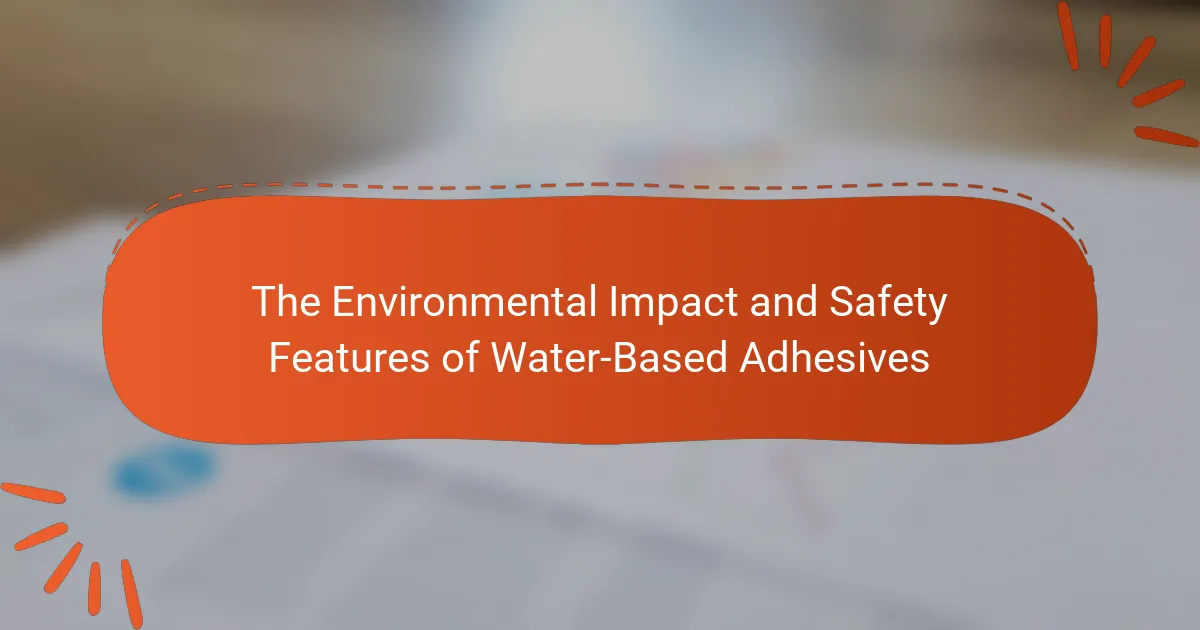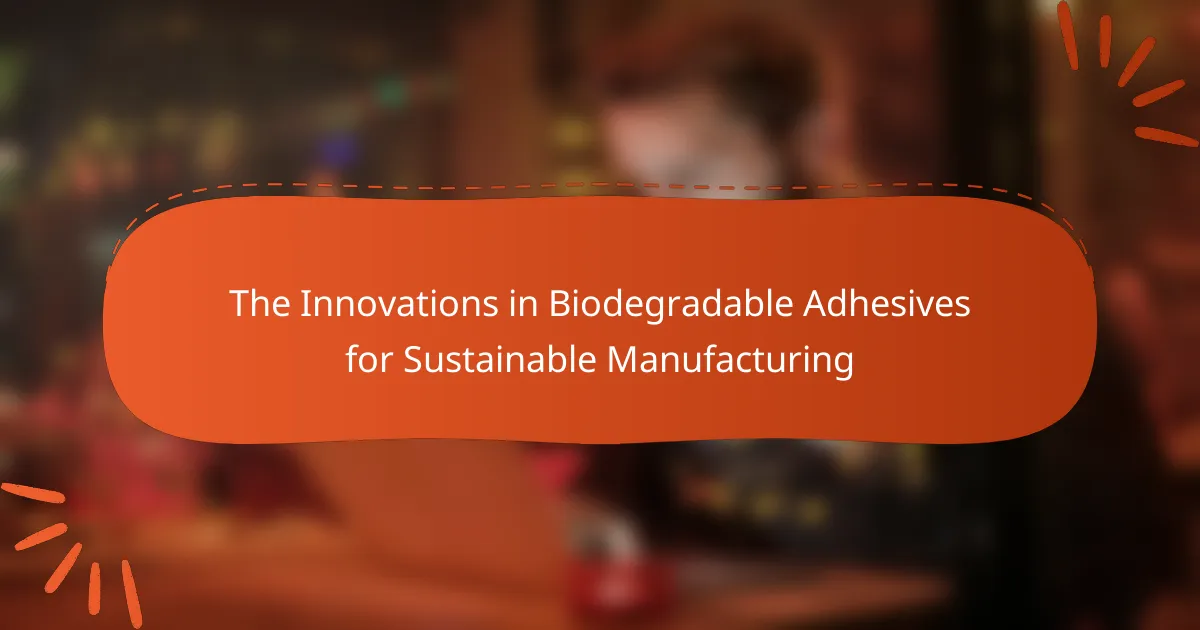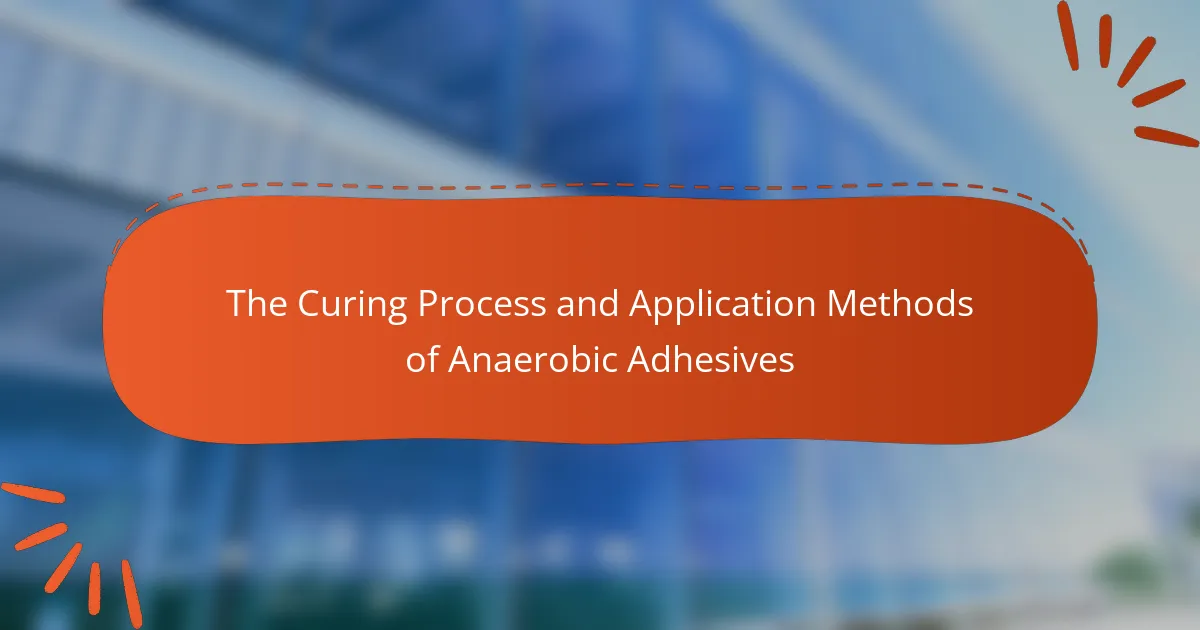Water-based adhesives are adhesives that utilize water as the primary solvent, making them a more environmentally friendly alternative to solvent-based adhesives. These adhesives are composed of polymers dispersed in water and are recognized for their low emissions of volatile organic compounds (VOCs), which contribute to improved indoor air quality. Common applications include woodworking, packaging, textiles, and automotive assembly, where their eco-friendly properties and safety features are advantageous. However, water-based adhesives face challenges such as lower bond strength, sensitivity to moisture, and longer drying times, which can affect their effectiveness in certain applications. Understanding these factors is essential for selecting the appropriate adhesive for specific uses.
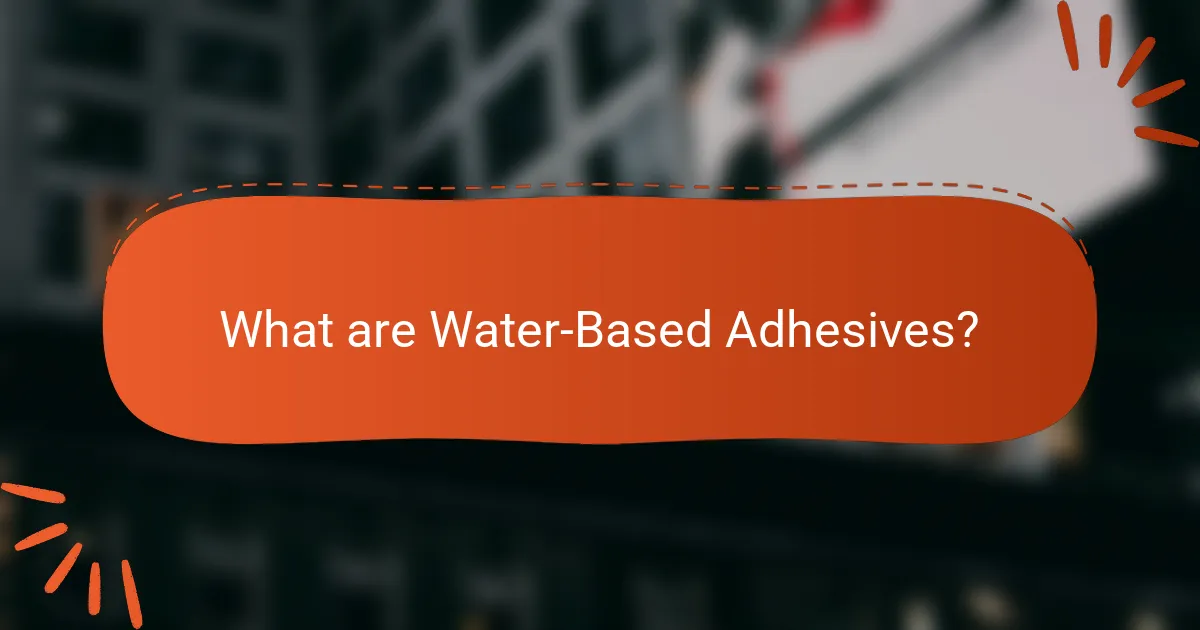
What are Water-Based Adhesives?
Water-based adhesives are adhesives that use water as the primary solvent. These adhesives typically consist of polymers dispersed in water. They are known for being environmentally friendly compared to solvent-based adhesives. Water-based adhesives emit fewer volatile organic compounds (VOCs). This characteristic contributes to better indoor air quality. They are commonly used in various applications, including woodworking and packaging. The use of water as a solvent makes them safer for users and the environment. Studies show that water-based adhesives can perform effectively in bonding materials.
How do Water-Based Adhesives differ from other adhesives?
Water-based adhesives differ from other adhesives primarily in their solvent composition. They use water as the main solvent, which reduces volatile organic compounds (VOCs). This characteristic makes them more environmentally friendly compared to solvent-based adhesives. Water-based adhesives typically have lower odor levels, enhancing user comfort during application. They also tend to be safer for health due to reduced chemical exposure. Additionally, water-based adhesives often require longer curing times but allow for easier cleanup with water. Their bonding strength can vary, making them suitable for specific applications like paper, wood, and some plastics.
What are the key components of Water-Based Adhesives?
The key components of water-based adhesives include water, polymers, and additives. Water acts as the solvent that dissolves the adhesive components. Polymers, such as polyvinyl acetate or acrylics, provide the adhesive properties. Additives enhance performance characteristics like viscosity, drying time, and stability. These components work together to create an effective bonding agent. Water-based adhesives are known for their low environmental impact and safety features. They typically emit fewer volatile organic compounds compared to solvent-based adhesives. This makes them safer for indoor use and better for the environment.
How do the components affect the performance of Water-Based Adhesives?
The components of water-based adhesives significantly influence their performance. Key components include polymers, solvents, and additives. Polymers provide the adhesive’s bonding strength and flexibility. Solvents affect the adhesive’s viscosity and drying time. Additives can enhance properties like adhesion, stability, and resistance to environmental factors. For example, the choice of polymer can determine the adhesive’s thermal stability and water resistance. Research indicates that the right combination of these components can improve overall performance and application versatility.
What are the primary environmental impacts of Water-Based Adhesives?
Water-based adhesives primarily impact the environment through lower volatile organic compound (VOC) emissions. These adhesives release significantly fewer VOCs compared to solvent-based options. This reduction helps improve air quality and lowers the risk of respiratory issues. Additionally, water-based adhesives are often biodegradable. Their use can minimize plastic waste in landfills. Furthermore, the production of water-based adhesives typically requires less energy. This results in a smaller carbon footprint compared to traditional adhesives. Overall, the environmental benefits of water-based adhesives make them a more sustainable choice.
How do Water-Based Adhesives contribute to air quality?
Water-based adhesives contribute positively to air quality by emitting fewer volatile organic compounds (VOCs) compared to solvent-based adhesives. VOCs are known to cause air pollution and health problems. Water-based adhesives typically contain less than 5% VOCs, significantly reducing indoor air pollution. This reduction helps create healthier indoor environments. Additionally, water-based adhesives support sustainable practices, as they are often made from renewable resources. Their lower toxicity levels also minimize the risk of respiratory issues among users. Studies have shown that using water-based adhesives can lead to improved air quality in both residential and commercial settings.
What is the significance of VOC emissions in Water-Based Adhesives?
VOC emissions in water-based adhesives are significant due to their impact on air quality and health. These emissions can contribute to indoor air pollution. High levels of VOCs can lead to respiratory issues and other health problems. Water-based adhesives are designed to minimize VOC emissions compared to solvent-based options. This makes them a safer choice for indoor applications. Regulations often limit VOC levels in adhesives to protect public health. For instance, the U.S. Environmental Protection Agency (EPA) has established guidelines for VOC emissions. This regulatory framework encourages the use of low-VOC products. Overall, reducing VOC emissions enhances the safety and environmental profile of water-based adhesives.
What safety features are inherent in Water-Based Adhesives?
Water-based adhesives have several inherent safety features. They typically contain low levels of volatile organic compounds (VOCs). This results in reduced air pollution and improved indoor air quality. Water-based adhesives are non-flammable, which minimizes fire hazards during application. They are also less likely to cause skin irritation compared to solvent-based adhesives. Many water-based adhesives are biodegradable, contributing to environmental safety. Additionally, they are often free from harmful solvents, reducing health risks for users. These features make water-based adhesives a safer choice for both consumers and the environment.
How do Water-Based Adhesives ensure user safety compared to solvent-based adhesives?
Water-based adhesives ensure user safety by being less toxic than solvent-based adhesives. They contain fewer volatile organic compounds (VOCs). This results in lower emissions of harmful chemicals into the air. Reduced VOC levels minimize respiratory issues for users. Water-based adhesives also have a lower risk of flammability. This characteristic makes them safer to handle and store. Additionally, they are less irritating to the skin and eyes. Studies show that water-based adhesives are associated with fewer health complaints compared to their solvent-based counterparts.
What are the toxicity levels associated with Water-Based Adhesives?
Water-based adhesives generally have low toxicity levels. They are formulated with water as the primary solvent, reducing harmful chemical emissions. Many water-based adhesives are free from volatile organic compounds (VOCs). This characteristic contributes to safer indoor air quality. Some formulations may contain small amounts of preservatives or additives. These can occasionally cause skin or respiratory irritation. However, the overall health risks are significantly lower compared to solvent-based adhesives. Studies indicate that exposure to water-based adhesives is less likely to result in toxic effects. This makes them a preferred choice for environmentally conscious applications.
How do Water-Based Adhesives promote sustainability?
Water-based adhesives promote sustainability by minimizing harmful emissions and reducing environmental impact. These adhesives contain lower levels of volatile organic compounds (VOCs) compared to solvent-based alternatives. Studies show that water-based adhesives can reduce air pollution and improve indoor air quality. They are often biodegradable and have less toxic components, making them safer for both users and the environment. Additionally, the use of renewable resources in their formulation further enhances their sustainability profile. This eco-friendly approach aligns with global efforts to reduce pollution and conserve resources.
What role do Water-Based Adhesives play in reducing environmental footprints?
Water-based adhesives significantly reduce environmental footprints by minimizing volatile organic compound (VOC) emissions. Unlike solvent-based adhesives, they contain fewer harmful chemicals. This leads to improved air quality during application and usage. Water-based adhesives are biodegradable, reducing waste in landfills. Their production often requires less energy compared to traditional adhesives. Research indicates that using water-based adhesives can lower greenhouse gas emissions. A study by the Environmental Protection Agency highlights their lower environmental impact. Overall, water-based adhesives contribute to sustainable practices in manufacturing and construction.
How can users make eco-friendly choices when selecting Water-Based Adhesives?
Users can make eco-friendly choices when selecting water-based adhesives by prioritizing products with low volatile organic compounds (VOCs). Low VOC adhesives reduce harmful emissions during application and curing. Additionally, users should look for adhesives certified by environmental standards, such as Green Seal or EcoLogo. These certifications ensure adherence to strict environmental criteria. Users can also choose adhesives made from renewable resources, which minimize reliance on fossil fuels. Furthermore, selecting adhesives that are biodegradable or non-toxic supports environmental sustainability. Reading product labels and researching brands can help users identify eco-friendly options. Finally, considering the adhesive’s lifecycle, including disposal methods, can enhance eco-friendliness.
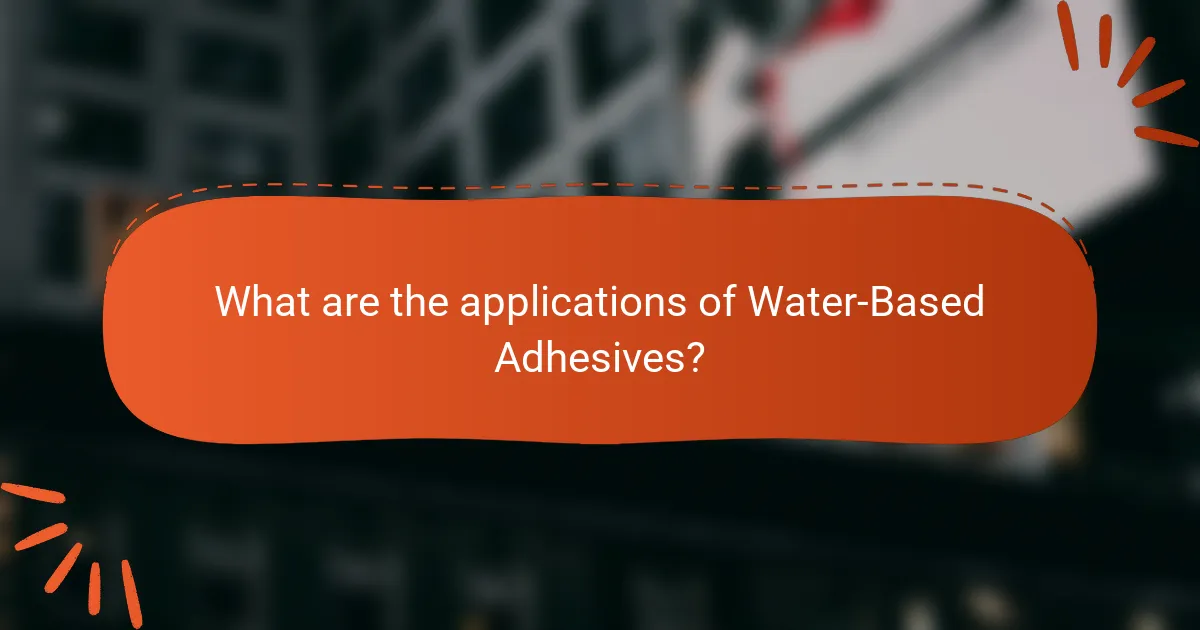
What are the applications of Water-Based Adhesives?
Water-based adhesives are used in various applications due to their eco-friendly properties. They are commonly utilized in woodworking for bonding materials like plywood and particleboard. In the textile industry, water-based adhesives bond fabrics and are preferred for their low toxicity. They are also used in packaging for sealing cartons and labels, enhancing product safety. Additionally, water-based adhesives find applications in the automotive industry for interior assembly and upholstery. Their versatility and lower environmental impact make them suitable for a wide range of industries.
In which industries are Water-Based Adhesives most commonly used?
Water-based adhesives are most commonly used in the packaging, woodworking, textiles, and construction industries. In packaging, they provide strong bonds for labels and cartons. Woodworking utilizes these adhesives for furniture and cabinetry assembly. The textile industry employs them for bonding fabrics and laminates. In construction, water-based adhesives are used for flooring and wall coverings. These industries favor water-based adhesives due to their eco-friendliness and low VOC emissions.
What are the specific benefits of Water-Based Adhesives in construction?
Water-based adhesives offer numerous benefits in construction. They are environmentally friendly due to their low volatile organic compounds (VOCs). This characteristic reduces air pollution and improves indoor air quality. Water-based adhesives are also non-toxic, making them safer for workers and occupants. Their easy cleanup with water simplifies the application process. Additionally, these adhesives provide strong bonding capabilities for various materials, including wood, metal, and plastics. They also exhibit excellent flexibility and resistance to temperature changes. Overall, the use of water-based adhesives contributes to sustainable construction practices.
How do Water-Based Adhesives perform in the packaging industry?
Water-based adhesives perform effectively in the packaging industry due to their low environmental impact and safety features. These adhesives are primarily composed of water, making them less harmful compared to solvent-based options. They provide strong bonding for various materials, including paper, cardboard, and plastics.
Additionally, water-based adhesives have quick drying times, which enhances production efficiency. They also exhibit excellent clarity and flexibility, which are essential for packaging aesthetics. According to a study by the Adhesive and Sealant Council, water-based adhesives are increasingly preferred for sustainable packaging solutions. Their use reduces volatile organic compounds (VOCs), contributing to improved air quality. This performance aligns with the industry’s shift towards eco-friendly practices.
What innovations are shaping the future of Water-Based Adhesives?
Innovations shaping the future of water-based adhesives include advancements in bio-based formulations. These formulations utilize renewable resources, reducing reliance on petroleum-based materials. Enhanced performance characteristics are also a focus. New technologies improve adhesion strength and durability under various conditions.
Additionally, the development of faster curing times is significant. Innovations allow adhesives to bond quickly, increasing manufacturing efficiency. Improved environmental profiles are another area of innovation. Many new adhesives have lower volatile organic compound (VOC) emissions, promoting safer indoor air quality.
Research indicates that these advancements contribute to sustainable practices in various industries. For instance, the use of water-based adhesives in packaging reduces environmental impact compared to solvent-based options.
How are advancements in technology enhancing Water-Based Adhesives?
Advancements in technology are enhancing water-based adhesives by improving their performance and sustainability. Innovations in polymer chemistry have led to stronger adhesion properties. Enhanced formulations now provide better moisture resistance and durability. New manufacturing processes allow for lower volatile organic compound (VOC) emissions. This contributes to a safer working environment. Additionally, advancements in application techniques increase efficiency and reduce waste. Research indicates that these improvements can lead to more environmentally friendly products. For example, a study by the American Chemical Society highlights the reduction of harmful substances in modern water-based adhesives.
What trends are emerging in the development of eco-friendly adhesives?
Emerging trends in the development of eco-friendly adhesives include the use of bio-based materials and improved formulations. Manufacturers are increasingly utilizing natural polymers derived from renewable resources. This shift aims to reduce reliance on petroleum-based products. Additionally, there is a focus on low-VOC (volatile organic compounds) formulations. These adhesives contribute to better indoor air quality. Innovations in technology are also leading to enhanced performance characteristics. For instance, some eco-friendly adhesives now offer stronger bonding capabilities. The trend towards sustainability is being driven by consumer demand for environmentally responsible products. Research indicates that the global market for eco-friendly adhesives is expected to grow significantly, reflecting this trend.

What challenges do Water-Based Adhesives face?
Water-based adhesives face several challenges that impact their effectiveness and application. One significant challenge is their lower bond strength compared to solvent-based adhesives. This can limit their use in high-stress applications. Another challenge is their sensitivity to moisture during the curing process. Excess moisture can weaken the bond or cause failure. Additionally, water-based adhesives may have a shorter shelf life due to microbial growth. Temperature fluctuations can also affect their performance, leading to inconsistency. Finally, they may require longer drying times, which can slow down production processes. These challenges highlight the need for careful consideration when selecting water-based adhesives for specific applications.
What limitations exist with Water-Based Adhesives?
Water-based adhesives have several limitations. They typically have lower bond strength compared to solvent-based adhesives. This can result in reduced performance in high-stress applications. Additionally, water-based adhesives may have longer curing times. Longer curing times can delay production processes. They are also sensitive to moisture and temperature fluctuations. Such sensitivity can compromise the adhesive’s effectiveness. Furthermore, water-based adhesives may not adhere well to certain surfaces. This includes oily or greasy materials. Finally, their shelf life can be shorter than that of solvent-based options. This can lead to increased waste and costs.
How do temperature and humidity affect the performance of Water-Based Adhesives?
Temperature and humidity significantly affect the performance of water-based adhesives. Higher temperatures can accelerate the drying process, potentially leading to a weaker bond if not managed properly. Conversely, low temperatures may slow down curing, prolonging the time required for the adhesive to reach its full strength.
Humidity plays a crucial role as well. High humidity can lead to excessive moisture in the adhesive, which may cause issues such as reduced adhesion and longer drying times. On the other hand, low humidity can facilitate quicker drying but may also lead to brittleness in the adhesive bond.
Research indicates that optimal performance of water-based adhesives typically occurs within a specific temperature and humidity range. For instance, a study by the Adhesive and Sealant Council suggests that maintaining a temperature between 20°C to 25°C and humidity levels around 50% enhances adhesive performance.
What are common misconceptions about Water-Based Adhesives?
Water-based adhesives are often misunderstood. A common misconception is that they are less effective than solvent-based adhesives. In reality, many water-based adhesives provide strong bonding capabilities. They are also believed to be unsuitable for high-temperature applications. However, certain formulations can withstand elevated temperatures effectively. Another misconception is that water-based adhesives are not durable. Studies show that they can offer comparable durability to their solvent-based counterparts. Additionally, some people think water-based adhesives are not waterproof. In fact, many water-based adhesives are designed to be water-resistant or even waterproof after curing. Lastly, it is often assumed that they are harmful to health. Water-based adhesives typically contain fewer volatile organic compounds (VOCs) than solvent-based options, making them safer for indoor use.
How can users effectively troubleshoot issues with Water-Based Adhesives?
To effectively troubleshoot issues with water-based adhesives, users should first identify the specific problem. Common issues include poor bonding, drying time, and adhesive separation. Users should check the surface preparation; clean and dry surfaces enhance adhesion. If bonding is weak, verify that the adhesive is suitable for the materials involved. Proper application techniques are essential; apply evenly and avoid excessive adhesive. Users should also consider environmental factors like humidity and temperature, which can affect performance. If drying time is longer than expected, ensure the adhesive is within its shelf life. Testing on a small area before full application can help identify potential issues. Regularly consulting manufacturer guidelines provides additional troubleshooting tips and ensures optimal use.
What tips can help improve adhesion with Water-Based Adhesives?
To improve adhesion with water-based adhesives, ensure surfaces are clean and dry. Contaminants like dust or oil can hinder bonding. Additionally, roughening smooth surfaces promotes better adhesion. This increases the surface area for the adhesive to grip. Applying the adhesive at the recommended temperature enhances its performance. Higher temperatures can improve flow and bonding. Use adequate pressure during application to ensure a strong bond. This helps the adhesive to spread evenly and create a better seal. Finally, allow sufficient curing time for optimal adhesion strength. Curing time varies by product, so refer to the manufacturer’s guidelines for specifics.
How can users ensure proper application and curing of Water-Based Adhesives?
Users can ensure proper application and curing of water-based adhesives by following specific guidelines. First, surface preparation is crucial; surfaces should be clean, dry, and free of contaminants. Next, users should apply the adhesive evenly using appropriate tools such as brushes or rollers. The recommended application thickness is typically between 0.5 to 1.5 mm.
Maintaining optimal temperature and humidity levels during application enhances adhesion and curing. Ideal conditions usually range from 65°F to 85°F and 40% to 60% relative humidity. Users must also allow adequate curing time, which can vary from a few hours to several days depending on the adhesive formulation.
Finally, users should avoid disturbing the bond during the curing process to ensure maximum strength. Following these steps optimizes the performance of water-based adhesives.
Water-based adhesives are environmentally friendly bonding agents that use water as their primary solvent, resulting in lower volatile organic compound (VOC) emissions compared to solvent-based adhesives. This article examines the components, performance, and safety features of water-based adhesives, highlighting their benefits in various applications, including woodworking, packaging, and construction. It also discusses the environmental impacts, particularly in improving air quality and promoting sustainability, while addressing challenges such as bond strength and sensitivity to moisture. Key insights into proper application techniques and troubleshooting are provided to enhance user experience with these adhesives.
